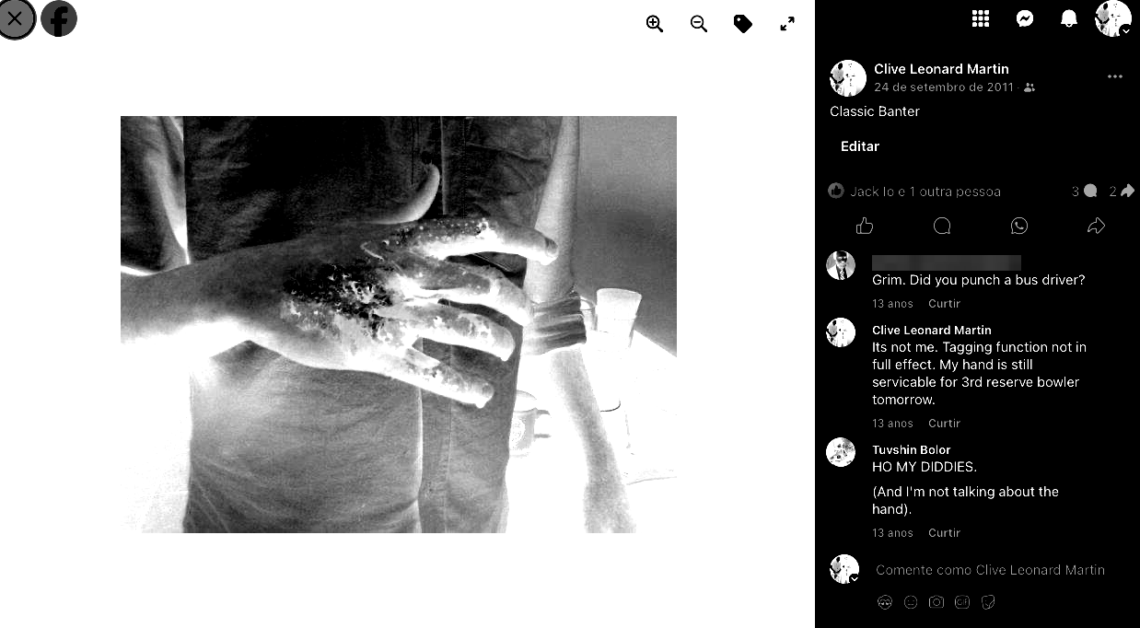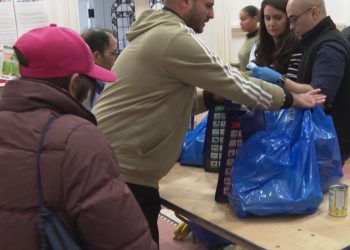This story is from the spring 2025 edition of VICE magazine: THE ROCK BOTTOM ISSUE. To subscribe to receive 4 print issues of our newly relaunched magazine each year, click here.
Look for it, you won’t find it. There isn’t a trace, not an errant red brick, nor a mangled old gate, and just a handful of haunted Facebook photos to remember it by. You can’t even use an ‘all that’s left…’ platitude, because there is, resolutely, nothing left.
Gentrification comes in two forms; the lick of paint and the bulldozer, and that place on Willow Street befell the latter; just like the blacksmiths and pigpens and Molly Houses that were there before. It’s as much a figment of East London’s past as the old ‘Hoxton Fields,’ a lost neighborhood where the hot-blooded playwright Ben Jonson killed a troubled young actor back in 1598, or the Holywell Mount plague pit, which ran alongside the long-buried River Walbrook.
For those who work in the area today (because make no mistake, nobody really ‘lives’ in such a place), Willow Street is a spot for phone calls, vape breaks, lunch dates, a discreet drug buy for the office Christmas party. The kind of urban backwater where you might take five minutes to follow up on that job offer, or leave a funny voice note for Thursday night’s Hinge prospect. Yet for myself and a select few others, just uttering the name of that road is enough to kick up the butterflies in the stomach.
Willow Street is now dominated by the Nobu Hotel London Shoreditch; a huge, spiky RIBA nightmare that juts out of the ground like a broken Scalextric track, serving wagyu tacos to finance cowboys. Next to it, they’ve built what’s known as a ‘pocket square,’ where a couple of bare pine trees stand forlorn in crushed stone beds—an oasis of airport-style dead space in the middle of what they once tried calling ‘East London Tech City.’
“They were mostly ket-riddled Italians with Jane’s Addiction haircuts, living and dying in light industrial units.”
But a decade and change ago, this was the site of a rogue housing experiment that I was embroiled in for six heady months; a time that appears to me now like a postoperative morphine dream. In my more sentimental moments, there’s a temptation to describe it as formative, yet really, it was anything but. If my life had any truly formative moments they happened before and after; in hospitals, nightclubs, crematoriums, other people’s parents’ bedrooms.
No: what Willow Street represents to me is the moment my life began to err. Where the standard paths for a young man started to cave in on themselves, giving way to a scenic, treacherous route through adulthood instead. Up till that point, a little bit of teenage hedonism was par for the course, but at Willow Street hedonism became life itself, a reason for getting up in the morning.
It started innocuously enough. My friend Jay, and his friend Mitchell, had been looking through the cheapest rentals in London, which led them to London Guardians, a company who ‘specialized’ in providing trustworthy tenants for vacant buildings. At the time, these kinds of schemes were booming: the capital was in the midst of a massive shift; municipal architecture put up in the 1970s was being torn down, the Olympics were on the horizon, and David Cameron was making grandiose speeches about Palo Alto coming to Hackney.
Yet there was still a surplus of empty buildings, many of which existed in a state of developmental purgatory; abandoned, but earmarked to become things like the Nobu Hotel. On top of that, legislation that outlawed squatting in residential properties had just been passed —which in turn, sent the crusties running towards shuttered shops and offices. We were meant to keep the squatters at bay, and occasionally you’d see them scoping out buildings; they were mostly ket-riddled Italians with Jane’s Addiction haircuts, living and dying in light industrial units.
Unlike similar companies, namely Camelot and Ad-Hoc, London Guardians was not known for its diligence. Tenants were supposed to be in a certain kind of employment (professional), of a certain age (25+), and properties were supposed to be refitted to a certain standard (habitable). But London Guardians seemed to circumvent these standards in favor of something far more casual. They didn’t ask too many questions—in fact, they didn’t ask any at all, which was perfect for a bunch of messheads looking to spend their early twenties in the thick of something.
Of the six of us who moved in, only three had full-time jobs. Myself and the other two subsisted within a micro-economy of student loans, doomed trial shifts, and stamping wrists at techno nights. You could pay your rent in cash, and even the smaller digits in pound coins (as I often did). We were meant to keep out intruders, yet the whole set-up was essentially a squat with a contract. It was a modern-day doss house, situated close to many of the historical ones.
“It looked like a level from Resident Evil, but also strangely sterile and institutional—like the kind of place you’d go to sign a register or pay a fine.”
The proprietor of London Guardians was a Maglite-wielding ex-solicitor called Roger Darke, a name that only added to the archaic menace of the situation. Roger had apparently worked for a rival guardianship firm in some capacity, before essentially taking their business model and doing it himself, only cheaper and nastier. His assistant was Paul, a guy who managed a string of wedding bands as a side hustle. Paul was the one who’d come over and bang on a faulty boiler or an alarm that wouldn’t turn off, and Roger was the one who ignored your questions and asked when the rent was coming. Later, Paul would vanish with half the company accounts in tow. He wouldn’t be the only person associated with London Guardians to disappear.
On the day we moved in, Roger gave us a two-minute tour, told us not to have any parties, and carried our cash deposits away in a matte black Jeep, leaving us to get to grips with our new living quarters. The building itself was a vast brick complex, and a shade of terracotta usually found on magistrates’ courts. There were wet concrete stairwells, dark, rubble-strewn gangways, and filthy UPVC windows. It looked like a level from Resident Evil, but also strangely sterile and institutional—like the kind of place you’d go to sign a register or pay a fine.
The twisted iron gate at the entrance gave way to a concrete loading bay, littered with Polish beer cans and decomposing copies of free city newspapers. Today, I try to imagine the covers of those papers. There would probably be something about a terror threat upgrade, and Peaches Geldof stumbling out of Punk or Trash in the arms of some neck-scarf bozo from a hype guitar band. There may have been something about then-mayor Boris Johnson, from the days when he was little more than a cheerleader for big business.
The loading bay suggested the building on Willow Street had once served some kind of commercial or industrial purpose, but when we moved in, it had most recently been home to the somewhat misleadingly named Oxbridge College, a so-called ‘diploma mill’ pumping out obscure qualifications at a premium. We’d occasionally find some of the detritus from the college, tangled landline wires and worksheets scrawled with broken English.
“Looking back on it now, you could probably accuse us of some pretty dubious voyeurism, but unless you never wanted to look through your own window, it was unavoidable.”
The setup was primitive, to say the least. There were no kitchen fittings apart from an industrial grade sink, and some Argos induction hobs we had made a rare investment in. I don’t recall there being a fridge, and there were no windows in at least two of the bedrooms. The showers were located in a different part of the building entirely. I always wondered what the office workers, staring out through windows opposite, must’ve thought of the parade of half-naked young men venturing down the fire escape every morning in bathrobes and flip flops, on steel steps where the all-night hot-dog sellers would dispose of their surplus grease at the end of a shift, occasionally asking a homeless person (or two) to shimmy over.
Perhaps they thought it was some kind of secret swimming pool, or underground twink sauna.
To add to the unsettling nature of it all, the building also directly faced the Hoxton Hotel, Rear Window-style. Looking back on it now, you could probably accuse us of some pretty dubious voyeurism, but unless you never wanted to look through your own window, it was unavoidable. In front of us was a vast tableau of transient residents; passed-out salarymen, city-break families, but mostly, mid-tier escorts and their Johns. Sometimes you’d take a fag break out the window, and witness some runaway suburban dad wagging his cock, while a depressed girl in lingerie stared at her nails. In the street below you’d often see what we came to understand were their minders and drivers, parked up in dark blue Mercs with the interior lights on—ready to roll with a Sports Direct baseball bat in case any funny business went down.
One afternoon, we even saw a BBW porno shoot. Two husky ladies in nighties stroked each other’s hair while a hench guy in a cap-sleeved T-shirt filmed them with a camcorder. He shut the curtains just after producing an enormous purple dildo, and so did we.
A lot of this happened in plain sight because nobody believed Willow Street to be habitable, which was a fair assumption to make. Jay lived in one of the rooms without windows. After a party, or during an after party, it would smell like a beer-flooded ashtray, and Pollock-esque black mold soon appeared on the ceiling. We were just yards from mega money, from civilization, but the place felt like a Venezuelan super prison.
Willow Street came with all manner of unsolvable quirks; security lights that blinked all night, alarms nobody knew the source of, electric cables swinging over the stairwells like nooses. In our section, the small, unventilated toilet had a radiator that nobody—not even the plumber Roger reluctantly called—could turn off. This meant it often felt like taking a shit in a Russian bathhouse. The owners of the building were still paying the bills—so, in the dead of winter, we would have the heating on full tilt, with the windows flung wide open, colliding hot air against cold in a way that I’m sure could have resulted in a localized weather incident.
If the building was a certifiable health hazard, the surrounding area wasn’t much safer. It’s a difficult one to talk about now, because in no way were these the ‘bad days’ of the East End, but it was a time when a few different versions of the area were rubbing up against each other, with often-violent results. There were still some remnants of the old villain spots—pound-in-a-pint-glass ‘strip pubs’ like The Old Axe and The Horns, guarded by misanthropic bouncers with baked potato hands. Aquarium, a highly ‘moody’ club famous for its sickeningly chlorinated knee-high swimming pool, was just a two-minute stroll from Willow Street, while the British Lion pub on Hackney Road was still known as an outpost of the far right. These were spots that all-but guaranteed you trouble, if you were looking for it.
We chose Willow Street because it was dirt cheap, and fitted our rogue, hand-to-mouth lifestyles at the time. I was comfortably the brokest person there, but these were the days when you could get by on a diet of stolen neoliberal sandwiches, Super Strongbow, and the kindness of richer friends. Often only eating once per day, I subsisted on high calorie, low nutrient products like microwave carbonaras and yellow label pastries. In many ways, it was a grim, quotidian lifestyle, one that put spores in your lungs and fear in your soul. But it was also an incredible time to be 22 years old and living in the midst of some kind of boom.
The words ‘Silicon Roundabout’ were lingering in the air back then; a dream of lucrative urban renewal inspired by Richard Florida’s ‘cluster theory’ of innovation, and realized in the form of cocaine, apps, dance music, and bad street art. You’d read the phrase often in Evening Standard hype pieces, and in The Kernel, an irreverent tech platform run by Milo Yiannopoulos before he started helping Donald Trump and Kanye West shill fascism to Internet America.
On top of all this economic action, there was an Indian Summer on the streets, and off the back of it came endless parties. These were the days before my friends were scattered to the four corners of the city, and almost everyone we knew lived within walking distance. Every night of the week there was some kind of free drinks event, or somebody who’d buy you a pint and give you a bump, or even just something you could loiter outside.
There were gallery launches, album launches, issue launches, restaurant launches. There were house parties, after parties, ketamine parties, Sunday night X Factor parties. People we knew were running nights, playing nights, working nights. It never felt like anyone would let work, or family, or neighbors get in the way of getting obliterated.
Occasionally, I listen back to playlists from these parties; Clams Casino, Zomby, early Joy Orbison, endless Lex Luger productions, and the first Weeknd EP. The music was whacked-out, warped, angry, but too fucked to do much about it. A sound that seemed to dovetail with the mood of the time.
“Of all the people involved with Willow Street who surely must be dead by now, he ranks first.”
Drugs, of course, were a major part of our lives back then. Although none of us had any money, we knew how to pool resources into buying gear, and there was a coterie of villains who’d come and find you at all hours. First and foremost, there was Haz, an affable Albanian from South London, who was happy to drive anywhere on weekends. Below him were Chinese Tom, Willy Wonka, Neil Young, Jay, Lorenzo, Brixton Mark, Caleb the primary school teacher (whose gear was always a last resort) and The Unknown Turk (so named because he was Turkish, and didn’t even offer an alias). Just thinking of these names sends a phantom drip down the back of my throat, and starts to rattle those butterflies again.
The gear we were taking, and the way we were taking it, felt very different to the 1970s cliches. This wasn’t Boogie Nights; there was no attached notion of success. Really it felt more like sniffing glue. It was about dipping a Chubb key into a filthy lottery ticket and trying to get a little buzz on. Pushing yourself into the deep.
Everyone else in the Willow Street complex was in a similar state of being—although most lived it very differently. Our neighbors, who resembled the cast of Waterworld, were refugees from the free party scene; god knows how old then, and likely no longer with us. They were hard-drug hippies, and long-term ‘Guardians,’ who for some reason were trusted by the company (although one of them smoking crack in the basement was apparently a step too far).
Chief among them was Jacques, a South African man who could’ve been anywhere between 30 and 60. He had an emaciated physique, and wide, pleading eyes that recalled both Gollum and Robert Carlyle’s mystic nutter in The Beach. Jacques was the lead tenant, and something of a busybody. He was the one who passed down Roger’s edicts, and carried out minor repair work.
Perhaps we would have respected him, even leaned on him, had he not been a speed freak and a pervert. Jacques had an incredible ability to appear in the showers at the same time as you, administering close, cloying hugs on sight. I only ever saw him in two states of dress; in his full John Lewis uniform, or naked (God knows he must’ve worked in the warehouse, because Jacques was not a man you’d want leading housewives around the white goods section). Of all the people involved with Willow Street who surely must be dead by now, he ranks first.
One autumn night, I was awoken by someone rattling hard on the chicken wire that enveloped my bedroom window. On the gangway stood a pill-spangled forty-something Latin American woman, demanding to know where “the party” was. Apparently the building had such a reputation for debauchery, that it was OK to wake someone up in their sleep demanding it.
Soon after came the first sight of real darkness, when one of the Guardians—a quiet blonde girl who lived alone in an old classroom—went unseen for weeks. Her family were ringing desperately, and eventually, Paul broke into her room with a crowbar, only to find her vanished, and having left behind a trail of unspecified human fluids all over the walls. “I’m pretty relieved she’s not there,” Roger told us. “Last thing I need is a dead fucking Guardian on my books.”
There were infinite incidents. One evening I came home to find that Mitchell, an Essex boy with a Mauna Loa temper, had kicked the living shit out of another stranger who had turned up demanding to know where the party was. Another time, a busker who’d squatted in the building until we came along had sworn vengeance on us. So, we set up a small arsenal of makeshift weapons—cricket bats, ball-peen hammers, kitchen knives—in case he came back looking for reprisals. Later, we had a massive house fire, which the police told us looked deliberate.
Once I came home to find that Hunter, perhaps the most deranged of all my flatmates, had put his fist through the front door, aggrieved at something or other. I had brought back a rather serious English Lit student I was seeing. She nearly threw up at the sight of the blood, but Hunter apologized, pouring us a couple of vodka and nothings—shards of glass still sticking out between his knuckles.
“I don’t know how you can live like this,” she said to me in bed that night. But I did live like that, and I carried on living like it for far too long somehow, in a city that prides itself on the merciless idea that it never stops changing.
Since then, London Guardians appears to have cleaned up its act, now operating with something resembling legitimacy. Meanwhile, Willow Street lives on as a ghostly dichotomy: a slick international hotel, with a litany of queasy local secrets.
Follow Clive Martin on X @clive_mart1n
This story is from the spring 2025 edition of VICE magazine: THE ROCK BOTTOM ISSUE. To subscribe to receive 4 print issues of our newly relaunched magazine each year, click here.
The post Squalor, Crime, Ketamine, and the Olympics: How I Spent 2012 in an East London Party Slum appeared first on VICE.




